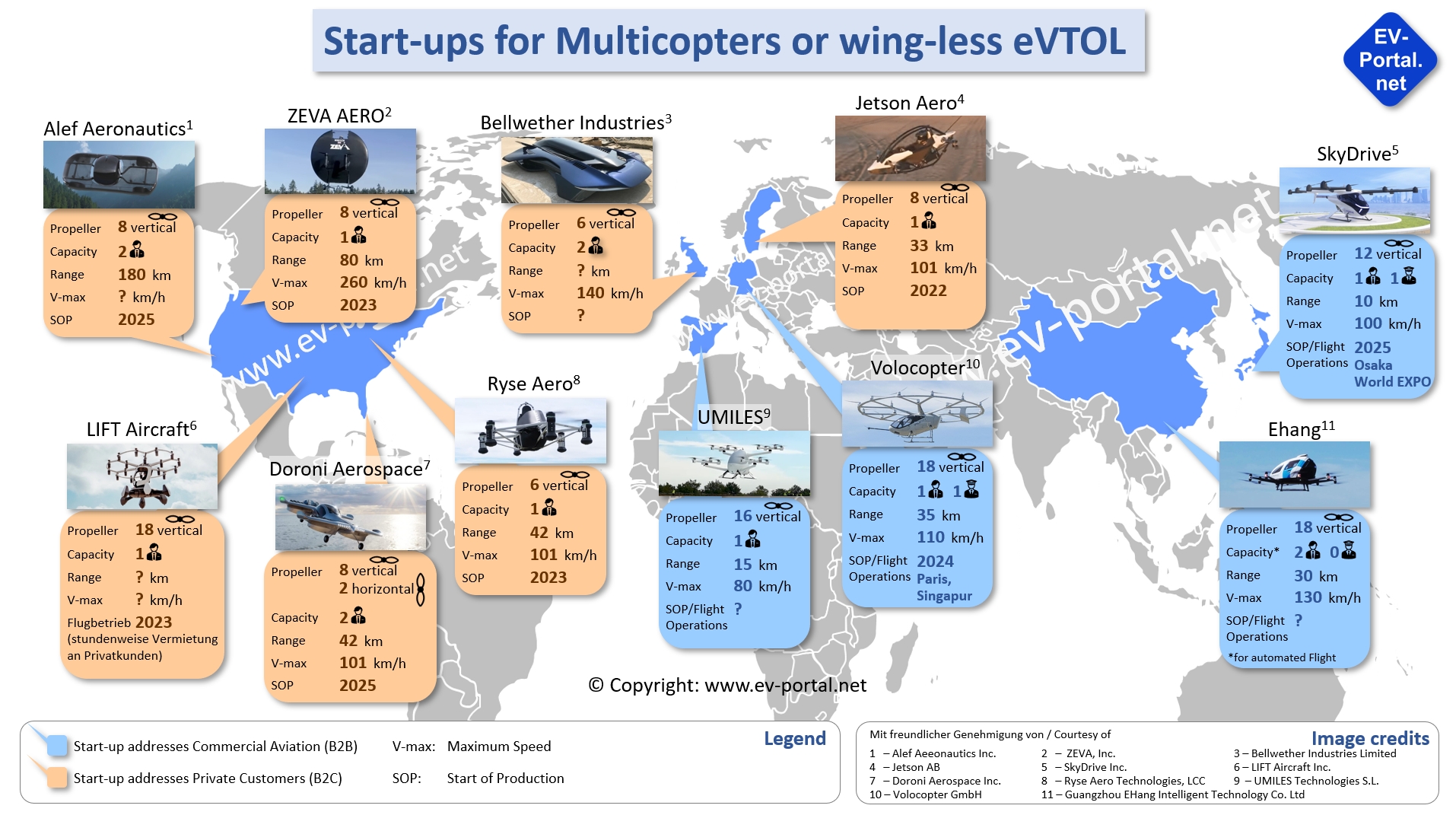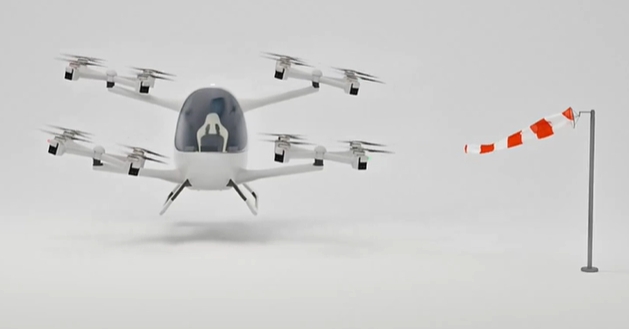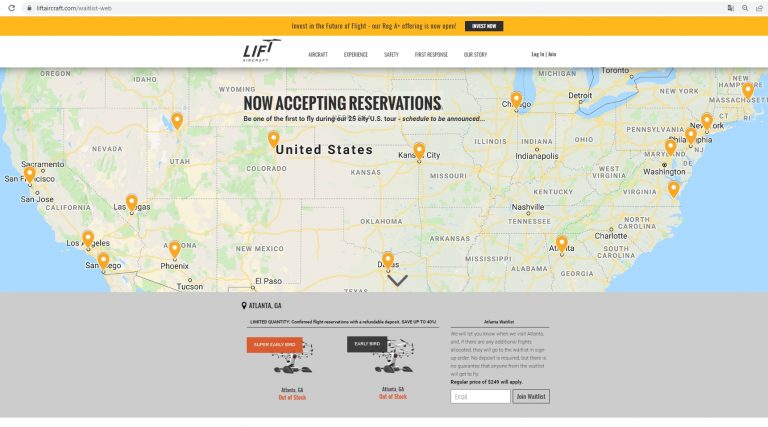eVTOL Start-ups for Multicopter

VOLOCITY from Volocopter
(Mit freundlicher Genehmigung/Courtesy of Volocopter GmbH [Media Hub])
Management Summary

Fig. 1 – Overview multicopter startups worldwide
Multicopters are wingless vertical take-off aircraft in which several vertically mounted propellers provide lift and propulsion. The technology of multicopters is similar to that of remote-controlled toy drones, although of course all components are designed to be much larger. Multicopters are being developed for both commercial aviation and private customers, and a complete overview of all startups can be found in Fig. 1.
One of the pioneers in multicopters for commercial aviation is the German company Volocopter, which was able to perform a manned first flight with a prototype as early as 2011.
The Chinese company Ehang is a direct competitor of Volocopter, the multicopter Ehang 216 developed by this start-up has very similar performance data as the Volocity. This start-up has also already conducted a large number of test flights, including in Europe.
For SkyDrive and UMILES, manned test flights are not planned until the coming years:
- The multicopter developed by Japanese start-up SkyDrive is similar to Volocity, and its first showcase will be World EXPO 2025 in Osaka.
- The Spanish start-up UMILES has developed a roll stabilization system for video drones, which is now to be transferred to multicopters.
Among the startups working on multicopters for private customers, 4 manufacturers are developing vertical take-off aircraft to the Ultralight Vehicle specification. Aircraft in this category may be flown in the U.S. without a pilot’s license or registration, with an empty weight of less than 115 kg (254 pounds) and a top speed of less than 101 km/h (55 knots).
- Jetson Aero’s multicopter has been on sale since 2022, and target customers are primarily private individuals who want to fly for recreational pleasure.
- Ryse Aero is marketing its multicopter as a working tool for farms with very large areas, with sales scheduled to start in 2023.
- LIFT Aircraft wants to rent its multicopter to tourist hot sports, reservations are already available on its website.
- ZEVA Aero also focuses on recreational pilots, dates for production and sales are not known to us.
The English start-up Bellwether Industries and the US start-up Doroni Aerospace are working on 2-seater multicopters for private customers:
- Bellwether has already developed a flying prototype, though there is no information yet on the sales launch.
- Doroni’s multicopter is still in development, with sales planned from the 2nd half of 2025.
A special feature is the U.S. start-up Alef Aeronautics, which is working on a flying car with multicopter technology flying car with multicopter technology. Alef emphasizes that the multicopter, called Model A, which is still under development, can drive like a passenger car on normal roads.
Multicopter Technology
The technology of multicopters is similar to that of remote-controlled toy drones and is relatively simple compared to helicopters:
- Vertical propellers ensure that multicopters can take off and land vertically.
- By varying the speed of the front and rear propellers, the drone can fly forward or backward.
- Via speed differences on the left and right side, the multicopter can also fly sideways.
- Each propeller is driven by its own electric motor.
Compared to wing-based eVTOL, multicopters generally have a shorter range, since the propellers must also rotate during cross-country flight in order to generate lift.
Since safety plays a very important role in flying, the propulsion system in all multicopters is designed with redundancy. This means that the failure of one or more propellers does not result in a crash because the remaining propellers still provide enough lift.
The maximum range of two-seat multicopters is currently about 35 km, and this is largely determined by the lithium-ion cells in the batteries. Increasing the energy density of lithium-ion cells is a very current research topic, so we can assume that the range of multicopters will increase in the coming years. However, multicopters will in principle never come close to the range of wing-based vertical take-off aircraft.
Multicopter for Commercial Aviation
A pioneer among the start-ups is the German company Volocopter from Bruchsal, Baden–Württemberg, the first flight of a manned multicopter was on Oct. 28, 2011. The development team of the pioneering years and the various, former GmbHs have given rise to the company Volocopter, which today has locations in Munich and Singapore in addition to Bruchsal.
Investors include prominent names such as Mercedes-Benz AG, DB Schenker, Continental and Blackrock. Since October 2022, Volocopter has no longer been led by co-founder Florian Reuter but by former Airbus manager Dirk Hoke.

Fig. 2 – Volocity from Volocopter
(Mit freundlicher Genehmigung/Courtesy of Volocopter GmbH [Media Hub])
Volocopter has developed a two–seat multicopter (1 passenger, 1 pilot) called Volocity to enable passenger flights in urban areas. It has 18 vertical rotors, a top speed of 110 km/h, and a range of at least 35 km (Fig. 2).
Volcopter’s business model includes both selling the multicopter to flight service operators and establishing its own flight operations. Volocopter’s first customers include ADAC, which is the largest German car drives club. ADAC operates a fleet of rescue helicopters in Germany, which is now to be expanded with the Volocity Multicopter. They have already purchased 2 Volocities and will test their use in air medical rescue; an option for another 150 Volocities was recently signed.
Volocopter works with exchangeable batteries, i.e. the empty battery is exchanged for a full battery after landing. Advantages of this approach are:
- Battery swapping is much faster than battery charging, so flight operations can be timed much tighter.
- The batteries can be charged more slowly on the ground and thus with less wear on the cells.
- During intensive flight operations, the HV battery has a shorter life than the aircraft itself. At the end of its service life, the battery can be replaced very easily, with no need for a workshop visit.
The Chinese company Ehang ia a direct competitor of Volocopter. Ehang has developed a two–seat multicopter called Ehang 216, which is comparable to Volocity in terms of performance data. However, the propellers of the Ehang 216 are not located above but below the cabin, which creates a potential risk of injury for passengers when the propellers rotate.

Fig. 3 – Ehang 216 at demo flight in Spain
(Mit freundlicher Genehmigung/Courtesy of Guangzhou EHang Intelligent Technology Co. Ltd. [Homepage])
Ehang can also already point to a large number of manned test and demonstration flights; the first flight in Europe took place in Spain on October 11, 2022 (Fig. 3).
Ehang is striving for automated air traffic in order to save the pilot and thus be able to increase passenger capacity. To this end, flight control centers are to be set up to control and monitor inner-city air traffic. We did not find a concrete roadmap for the implementation of these plans on Ehang’s homepage.
The Spanish company UMILES was founded by 2 brothers who previously worked very intensively with unmanned video drones for the film and advertising industry. In particular, technologies for roll stabilization of drones were developed.

Fig. 4 – UMILES technology for roll stabiliization
(Mit freundlicher Genehmigung/Courtesy of UMILES Technologies S.L. [Homepage])

Fig. 5 – Unmanned test flight in Toulouse, France
(Mit freundlicher Genehmigung/Courtesy of UMILES Technologies S.L. [Homepage])
Fig. 4 shows the principle. In each case, 4 propellers are combined in a movable carrier frame; in the event of a crosswind, the carrier frame is tilted against the wind direction. The cabin itself remains stable, which represents a significant gain in comfort for the passengers.
The principle of roll stabilization is now to be applied to a manned single-seat multicopter. This has 16 vertical propellers, a payload of 100 kg, a top speed of 80 km/h and a range of 15 km. Unmanned test flights have already been conducted in 2022. fig. 5, top right, shows a test flight in Toulouse.
A roadmap with the dates for certification and series production of the multicopter is not known.

Fig. 6 – Sketch SkyDrive Multicopter
(Mit freundlicher Genehmigung/Courtesy of SkyDrive Inc. [Homepage]])
The Japanese company SkyDrive is also developing a two-seater multicopter, although no flyable model exists yet. Demonstration flights have not been announced until 2024, with the first high-profile use planned for World EXPO 2025 in Osaka.
Investors include a number of Japanese banks and companies, and a partnership agreement with Toyota has been in place since 2019.
Multicopter for Private Customers
Video 1 – Flight Jetson-ONE over dune landscape
(Mit freundlicher Genehmigung/Courtesy of Jetson AB [Homepage])
Swedish startup Jetson Aero has developed a single-seat multicopter called the Jetson ONE, which has been on sale since 2022 at a price of $98,000. The Jetson ONE meets ultralight vehicle regulations in the U.S. and therefore can be flown without a pilot’s license.
The video on the home page showing a Jetson ONE flying over a picturesque dune landscape at sunset really intrigued us in the editorial team (see Video 1). It brings back memories of Luke Skywalker in his X34 landspeeder gliding over the desert in the 1977 Star Wars movie.
Ryse Aero Technologies of Ohio, USA, is also developing a single-seat multicopter for private customers (Fig. 8) that falls under ultralight vehicle regulation in the USA (no pilot license required).
However, Ryse has a very different clientele in mind. Ryse aims to assist U.S. farmers with day-to-day tasks on typically very large farms, such as rounding up livestock, controlling crop growth, etc. Sales will start in 2023, reservations should be available soon via the homepage.
The company LIFT Aircraft from Austin/Texas is planning with a different business model. The single-seat multicopter HEXA (Fig. 9) developed by LIFT is not to be sold but rented to private customers. HEXA falls under ultralight vehicle regulation and can therefore be flown in the U.S. without a pilot’s license. Thanks to the floats, HEXA can also land on water.
Rental is handled through an app that allows customers to book a HEXA flight in their area. Before the flight, there is a briefing on the aircraft, which includes a virtual flight using a VR flight simulator. Afterwards, the customer gets to fly HEXA for 8-15 minutes, with a rental fee of $249.
Concrete details about the start of flight operations are missing from the homepage, but reservations can already be made for a large number of cities in the USA (Fig. 10). Of course, flights to tourist hot spots such as the Statue of Liberty in New York or Niagara Falls are particularly interesting. We are curious to see at which sights LIFT Aircraft will offer a HEXA flight.
The English company Bellwether is developing a multicopter that could have come out of a Batman movie. The design is significantly different from all other designs because the vertical rotors are completely encapsulated in the missile. A flyable two-seat prototype already exists, this apparently has 6 vertical propellers (Fig. 11).
Based on the prototype, a three-seater model (2 passengers, 1 pilot) named Oryx is to be developed, for which further investors are being sought. The first flight is planned for 2023 in Dubai. A typical application is the flight from London Heathrow to London’s financial center Canary Wharf.
The American company ZEVA Aero from Washington State is also developing a multicopter with an iconic design. The current flight model is called Z2, is a single-seat multicopter with 8 vertical propellers.and is reminiscent of a UFO tilted by 45% (Fig. 12).
The performance data of Z2 are striking; with a speed of almost 260 km/h (160 mph) and a range of 80 km (50 miles), the Z2 is best-in-class among multicopters. However, this means the Z2 no longer falls under Ultralight Vehicle regulations.
The roadmap on the Zeva homepage remains very vague regarding future milestones such as FAA approval, start of series production, etc.

Fig. 13 – SkyDock concept from ZEVA
(Mit freundlicher Genehmigung/Courtesy of ZEVA. Inc. [Homepage])
Bellwether and Zeva have both developed very futuristic concepts regarding inner-city air traffic. Both propose that multicopters land directly at the top stacks of high-rise buildings. Zeva is also talking about so-called point-to-point travel here, where the time lost by checking in and out at an airport is to be avoided.
While Bellwether is still planning with a landing platform fixed to the side of the high-rise building, the so-called SkyDockTM concept goes even further. The idea is that the Zeva multicopter docks at an outer door of the skyscrapers, and the passenger goes directly from the aircraft into the skyscraper (Fig. 13).
When and how the SkyDockTM concept will be implemented is not mentioned on the homepage.
Flying cars with Multicopter Technology
U.S. startup Alef Aeronautics was founded in California in 2015, and among its first investors was Tim Draper, who invested $3 million in the company. Draper also became known for his early investment in Tesla and SpaceX.

Fig. 14 – Model A from Alef Aeronautics
(Mit freundlicher Genehmigung/Courtesy of Alef Aeronautics Inc. [Press Kit])
The two-seat flying car called MODEL A developed by Alef has 4 vertical propellers each in the front and rear, with the propellers completely encapsulated in the air-permeable body (Fig. 14). The Model A is intended to be able to move on the road like a normal car, and the targeted range on the road is about 320 km (200 ml).

Fig. 15 – Model A in forward flight with body turned sideways and tilted forward
(Mit freundlicher Genehmigung/Courtesy of Alef Aeronautics Inc. [Press Kit])
Interestingly, no horizontal propellers are planned for the Model A for forward flight. Instead, after vertical takeoff, the Model A is turned to the side and then tilted forward about 75 degrees so that the vertical propellers can provide propulsion. The passing capsule is rotatably mounted so that the pilot can continue to look forward (Fig. 15).
The Model A currently costs $300,000, with sales launch planned for Q4/2025.





